July 2023
Monday July 3 Relaxing in Provincetown with Susan, enjoying the view. Still seeing a few common eiders in the bay, the very, very southern tip of their breeding range. Most of their eider buddies are way up north, along the northern coast of North America and Greenland. I see the appeal of just staying here, not bothering with the long migration.
Spectacular, practically glowing, amber red buck moon this evening. A supermoon, the closest the full moon comes to the earth in its elliptical orbit, making it appear larger and brighter than a typical full moon. So amazing that nearly everyone on the restaurant deck where we were finishing dinner excitedly got up to take photos of it rising over the water. As did we. Watching for a few minutes, we saw it appear and then disappear behind horizontal layers of clouds low on the horizon. I'm always amazed that within a few minutes, you can actually see it rising in the night sky. The NY Times had photos of it from around the world the next day; my favorite was the moon over the lighthouse at Whitley Bay, Northumberland, England, about 15 miles from where my parents grew up.
Tuesday July 4 Independence Day parade in Provincetown yielded this patriotic eagle.
Wednesday July 5 On our morning hike with Ranger Nick, fog over the Atlantic and mist rolling in across the dunes. Saw chicken of the woods mushrooms growing on a tree, past prime eating condition though.
Thursday July 6 Early morning walk at low tide.
Saw several of these circular creatures; they looked to me as if they should be hard, but they were almost jelly-like.
A few elegant least terns, flying along the edge of the sand bars, cheeping their high-pitched call. As I watched, one dove, just glancing the water, coming up with a small fish in its bill. They're the smallest of the tern family, at only 9" long, weighing about one and a half ounces, less than half a stick of butter. (In contrast, the largest tern in North America, the Caspian Tern, is roughly 20" long and weighs 24 ounces.) Least tern numbers declined dramatically in the 1960s and 1970s; monitoring and protection of least terns along the Massachusetts shoreline by Mass Audubon (in partnership with other agencies and private landowners) has led to a three-fold increase in their numbers since then.
A few laughing gulls, too, with their black heads and red bills. One gull standing on the sand had an iridescent blue fishing lure, about 6" long, hooked into its foot and was having trouble flying, just getting a few inches off the sand and managing a few feet forward each time it tried to take off.
Later on in the afternoon, I dropped Susan off at Lieutenant's Island in Wellfleet to meet up with her Mass Audubon volunteer group that protects diamond terrapin nests. I drove on to Wellfleet harbor to check on the osprey nest at the parking lot. When I arrived, one adult was visible, standing on the nest. After a few minutes, one of the young stood up, then a second head appeared. (The wings and back of the adults are solid dark brown while those of the young are speckled.) And when the other adult arrived, a third young osprey stood up, too. After a bit, I noticed that the adult on the right of the photo was tearing at a fish; you can just see the fish head towards the right hand side of the nest.
The nest, which seemed so huge last month with just the two adults on it, is now crowded, especially when one of the young starts flapping its wings, getting ready to fledge.
After enjoying the osprey for a while, I went to the Audubon sanctuary to watch the purple martins at their nesting boxes by the visitor center. After seeing the purple martins, I headed down the trail from the visitor center, and spotted a young coyote at the side of the trail.
Monday July 10 Rainy day in Boston today, complete downpour this morning, flooding reported in Vermont. In a break in the rain, I picked up Maddie at the groomer and stopped at the Arb on the way home. It was glorious: lush, verdant, inviting. And we were the only ones there.
This blossoming Japanese Stewartia caught my eye, and, when I looked closer, I noticed its wonderful bark, gleaming patches of chocolate (both dark and milk), tan, and light and dark grays.
On our evening walk, looking east, saw this rainbow.
And here's a tired Maddie, freshly groomed, at maximum cuteness, at the end of the day.
Tuesday July 11 This morning, my neighbor, Sue, took this photo looking west. Seeing the two rainbows looking east and west, evening and morning, made me remember that rainbows are always seen with the sun shining from behind you.
Thursday July 13 Another trip to the Wellfleet osprey nest. The three young all still on the nest, all of them flapping their wings, getting ready to fly. I liked this photo with the sparrow zooming by from the left, and another perched on the wooden framework supporting the nest. Sparrows fly right into the midst of the osprey nest, beneath the top; I'm wondering if they have their nests inside the osprey nest.
Sunday July 16 Went on the Provincetown Art Association and Museum garden tour this morning. Gorgeous gardens, beautiful flowers. So many homeowners in Provincetown have wonderful gardens. This was one of the first ones we saw, fronting right onto Commercial Street. Another set behind an art gallery on Commercial Street, masses of flowers going down to the beach.
Wednesday July 26 At the Mass Audubon Trailside Museum in the Blue Hills this afternoon for a meeting of a committee that advises Audubon on renovation and construction projects. The committee is mostly retired friends of Audubon (a couple of architects, a landscape architect, an ecologist and me), along with a few Audubon staff. But before we could even think of giving any professional advice, we had to check out the otter that lives at Trailside: first snoozing inside a hollow log, then poking its head up, and finally coming over to investigate us.
After our discussion and a tour of the Trailside natural history museum, we went outside to have a look at the property. And, much to our delight, there was Norm Smith holding a 5 week old kestrel! (I was tickled that he was transporting it in a dog/cat carrier box.) He'd been told of a nest where the parents had died and went to rescue the juvenile. Recently, they've discovered that if you put the juvenile into another nest with other young of the same age, the parents will treat it as one of their own. Apparently they can't count. So he had plans to put this one in a nearby nest he knew about.
Norm is known in the bird world for his work capturing snowy owls at Logan airport in the winter; the owls are attracted to the uninhabited, tundra-like landscape there. He then releases them on the north or south shore. I once saw him release one at Plum Island - incredible to see it come out of the carrier on his arm, and fly off and away. Following the historic irruption of snowy owls in the winter of 2013-14 (Norm captured over a hundred snowy owls at Logan that winter), several bird groups formed Project Snowstorm, which tracks snowy owls using GPS devices. The website has maps tracking migration routes of individual owls captured in the winter in the more southern
regions of Canada and the eastern US, following them as they fly back to the high Arctic in the spring. Very cool.
Thursday July 27 Big thunderstorm this evening, torrential rain, high winds. Followed by this rainbow.
Saturday July 29 Walking home from a wedding dinner in New Haven, we glimpsed fireflies flashing yellow in the twilight. Susan calls them lightning bugs. But growing up, we always called them fireflies. The molecule within the firefly that produces light is called luciferin; the name derives from the Latin lucifer, which means "light bringer".
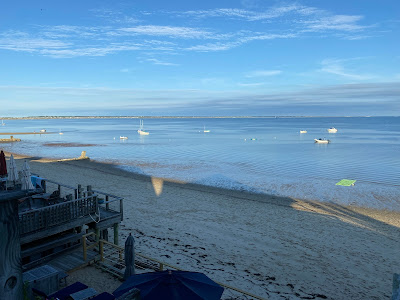
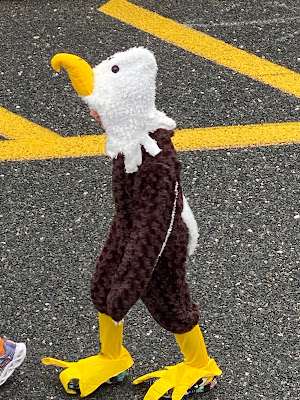


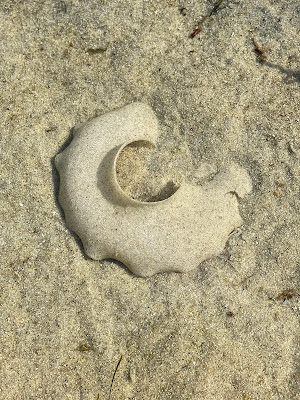


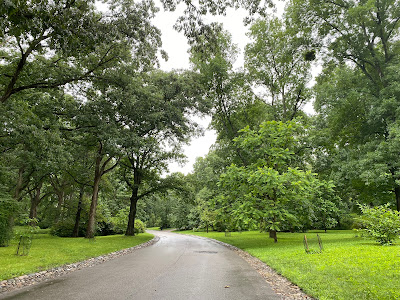




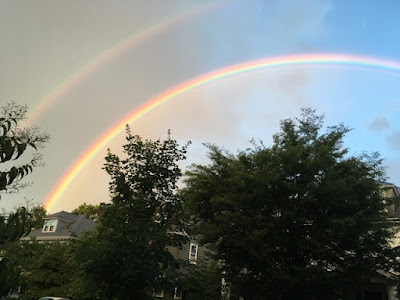









Comments
Post a Comment